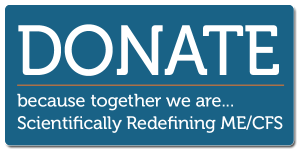Peterson's Atypical Subset Opens New View of ME/CFS in Columbia/Simmaron Publication
“We now have biological evidence that the triggers for ME/CFS may involve distinct pathways to disease, or, in some cases, predispose individuals to the later development of serious comorbidities.” Dr. Mady Hornig.
The Subset Makers
 Over the past couple of years the Simmaron Research Foundation and Center for Infection and Immunity at Columbia University and others have begun to pump out some long awaited subsets. This week, new findings were published by Columbia and Simmaron that define 2 subsets.
Over the past couple of years the Simmaron Research Foundation and Center for Infection and Immunity at Columbia University and others have begun to pump out some long awaited subsets. This week, new findings were published by Columbia and Simmaron that define 2 subsets.
They’re not the usual suspects (infectious trigger vs non-infectious trigger; gradual onset vs acute onset). In fact, they involve subsets few would have predicted a couple of years ago. They suggest that we might be in for some real surprises over time.Short Duration vs Long Duration Subset: Two years ago, the Simmaron Research Foundation collaborated with Ian Lipkin and other doctors to uncover a subset few had anticipated: short duration patients vs long duration patients.The Atypical Patient or "Peterson Subset": Now comes a subset of atypical chronic fatigue syndrome (ME/CFS) patients (the “Peterson Subset") that Dr. Peterson had long wondered about. These patients had ME/CFS but tended to follow a different course. Some had had unusual exposures (unusual infections, blood transfusions); others developed serious illnesses (cancer, autoimmune diseases, etc.) that Dr. Peterson didn't see in the rest of the population.Dr. Hornig talked about how the atypical subset came about. Like so many breakthroughs in medicine it took a careful and observant doctor/researcher to bring it about. This study, she said, was a testament to:
“Dr. Peterson’s clinical acumen, his long-term follow up of this patient population and his attentiveness to the full range of complex, serious medical disorders that might develop. The classical group had been followed for similar lengths of time but had not developed these more severe, serious comorbidities.”The atypical vs classical distinction was pre-established by Dr. Peterson before the analysis. Based on his wide-ranging clinical experience, the atypical group stood out for either: 1) the presence of unusual precursors (triggers) of ME/CFS or; 2) the development of more unusual and severe comorbidities over varying (and often long-term) intervals after ME/CFS onset."
 Dr. Peterson felt the unusual outcomes weren't just the result of chance: something different was going on - something that he felt as a doctor needed to be identified. What if, he thought, there was a way to identify these unusual patients before they started developing these significant illnesses. Then he could do more extensive cancer or immune screens and watch these patients more closely.Plus, these patients could be inadvertently bollixing up the results of ME/CFS studies. Peterson was so sure, in fact, this subset was different that he had its effects assessed during the first Simmaron/CII spinal fluid study. Peterson turned out to be right: the atypical subset had such an effect on the results that it had to be removed.The next step was a study comparing the two groups. Using Dr. Peterson's spinal fluid samples, The Center for Infection and Immunity (CII) at Columbia found that "Peterson Subset" not only had markedly different immune findings but displayed a different pattern of immune results as well. Dr. Peterson is Scientific Advisor to Simmaron and Gunnar Gottschalk was its Research Manager.
Dr. Peterson felt the unusual outcomes weren't just the result of chance: something different was going on - something that he felt as a doctor needed to be identified. What if, he thought, there was a way to identify these unusual patients before they started developing these significant illnesses. Then he could do more extensive cancer or immune screens and watch these patients more closely.Plus, these patients could be inadvertently bollixing up the results of ME/CFS studies. Peterson was so sure, in fact, this subset was different that he had its effects assessed during the first Simmaron/CII spinal fluid study. Peterson turned out to be right: the atypical subset had such an effect on the results that it had to be removed.The next step was a study comparing the two groups. Using Dr. Peterson's spinal fluid samples, The Center for Infection and Immunity (CII) at Columbia found that "Peterson Subset" not only had markedly different immune findings but displayed a different pattern of immune results as well. Dr. Peterson is Scientific Advisor to Simmaron and Gunnar Gottschalk was its Research Manager.
Immune network analysis of cerebrospinal fluid in myalgic encephalomyelitis/chronic fatigue syndrome with atypical and classical presentations M Hornig1,2, CG Gottschalk3, ML Eddy1, X Che1, JE Ukaigwe1, DL Peterson3 and WI Lipkin. Translational Psychiatry (2017) 7, e1080; doi:10.1038/tp.2017.44; published online 4 April 2017
The Atypical Subset
What does a typical chronic fatigue syndrome (ME/CFS) patient look like? Something like someone who suddenly comes down with a flu-like illness and never recovers. They may get better or they may get worse, but they don’t come down with cancer, an autoimmune illness, seizures or other significant illnesses.An atypical patient, on the other hand, might have a history of viral infection (viral encephalitis) or have been exposed to unusual pathogens during foreign travel or had a blood transfusion before becoming ill. They also tended to be more severely cognitively impaired and had more neurological complaints. They tended to suffer from severe diseases as well.Many of these illnesses appeared long after the ME/CFS diagnosis. In fact, at the time of diagnosis these patients looked like a typical ME/CFS patient. This study suggests, though, that very early on, something different was happening in their central nervous systems.
The Atypical Patients in the Study (the "Peterson Subset"):
- Atypical multiple sclerosis - 3
- Other autoimmune/inflammatory disorders - 4
- Cancer - 8 (brain-3, breast-2, lymphoma -2, pancreatic-1)
- Infections - 2 (West Nile Virus encephalitis - 1; Unspecified viral encephalitis - 1)
- Illness during foreign travel - 2
- Illness after blood transfusion - 1
- Seizure disorder - 6
- Gulf War Illness - 1
Immune "Exhaustion"?
This "broadly based" immune study compared 51 cytokines and other immune factors in the cerebral spinal fluid of 32 typical and 19 atypical ME/CFS patients. These numbers at first glance may seem small but they're actually quite large for spinal fluid studies.The Simmaron Research Foundation/Center for Infection and Immunity's prior studies suggested that typical ME/CFS patients’ immune systems went on high alert for the first couple of years of illness but then went into slumber mode. In fact, it was more than slumber mode: their immune activity essentially tanked - leading to the hypothesis that frantic activity of the first couple of years might have left their immune systems depleted. This study suggests that the "Peterson Subset" follows a markedly different pattern. The major burst of immune activity early on followed by equally dramatic downturns found in the typical patients is gone. Instead the study suggests that the immune systems of the atypical patients essentially started off low and stayed low.Almost half the immune factors tested (IL1β, IL5, IL7, IL13, IL17A, IFNα2, IFNγ, TNFα, TRAIL (TNFSF10), CCL2, CCL7, CXCL5, CXCL9, CSF3 (GCSF), βNGF, resistin, serpin E1) were lower early in the illness in the atypical group.As the illness proceeded, though, the pattern changed again: the atypical groups’ immune system actually revved up again.When I asked if immune exhaustion was bringing the immune system down early in the atypical group, Mady Hornig replied:
This study suggests that the "Peterson Subset" follows a markedly different pattern. The major burst of immune activity early on followed by equally dramatic downturns found in the typical patients is gone. Instead the study suggests that the immune systems of the atypical patients essentially started off low and stayed low.Almost half the immune factors tested (IL1β, IL5, IL7, IL13, IL17A, IFNα2, IFNγ, TNFα, TRAIL (TNFSF10), CCL2, CCL7, CXCL5, CXCL9, CSF3 (GCSF), βNGF, resistin, serpin E1) were lower early in the illness in the atypical group.As the illness proceeded, though, the pattern changed again: the atypical groups’ immune system actually revved up again.When I asked if immune exhaustion was bringing the immune system down early in the atypical group, Mady Hornig replied:
"We don't know yet. Our additional finding of an interaction of diagnostic subset with duration of illness - wherein the atypical group showed a pattern of increased levels of immune molecules with longer duration of illness, as opposed to the dampened immune profiles in the classical group with longer illness duration compared to classical ME/CFS in the early stages of disease (as we had seen in the immune profiling work based on plasma samples) - suggests that the response tends to be more suppressed at the onset of ME/CFS in the atypical group."
Could that dampened immune response early in their illness be contributing to the illnesses the atypical group experienced later? Dr. Hornig again cautioned about the need to replicate the study but suggested it might. A viral trigger could have blasted their immune systems or vice versa - a problematic immune system could have allowed a virus in …
"However, dampening of inflammatory (so-called Th1/Th17-type) responses might be expected to restrict an individual’s ability to keep problematic microbes from replicating. Certain viruses - even common ones implicated in ME/CFS in some studies, such as Epstein-Barr Virus (EBV) - are well-known to be associated with development of certain cancers; however, only a fraction of those infected with EBV develop cancers.It is a bit of a chicken-egg conundrum: EBV could alter immune responses of T/NK cells to increase cancer risk, or altered T/NK responses at the time of EBV infection could be the critical factor. Alternatively, reduced Th1/Th17-type immune profiles after infection - along with reduced T regulatory cell responses - might skew some individuals toward autoimmunity, raising the risk for more severe autoimmune diseases, including atypical multiple sclerosis or even autoimmune-mediated epileptiform disorders. But at this early juncture this remains only speculation."
Epstein-Barr Virus (EBV) brings up the age and exposure question. It's much more difficult for the immune system to corral or ward off EBV if EBV is encountered for the first time at a later age (during or after adolescence). That difficulty shows up as the months long fight to beat EBV called infectious mononucleosis.A meta-analysis of studies examining many environmental risk factors for multiple sclerosis (including vaccinations, comorbid diseases, surgeries, traumatic events and accidents, exposure to environmental agents, and biochemical, infectious, and musculoskeletal biomarkers) found that only three were associated with an increased risk of coming down with MS. Two of those concerned EBV (having had infectious mononucleosis, IgG seropositivity to EBNA). (The last significant factor was smoking).Could a later exposure to EBV which resulted in infectious mononucleosis be the straw, so to speak, that ultimately broke the camel's back for some of the atypical patients?Dr. Hornig agreed that a study parsing out the rates of infectious mononucleosis in ME/CFS could be helpful but said it was hard to know at this point if IM played a role. She said that the CII group was investigating EBV further:
"Hard to know (if late exposure to EBV is involved)- we are looking for clues suggesting greater risk for autoantibody-mediated disease in EBV and other virally-exposed subsets of ME/CFS. We do know that females have higher risk for autoimmune disease, but the sex skew only begins after puberty (when females might have come down with IM [Infectious Mononucleosis])."
Poor Networking
Not only was less immune activation present earlier in the atypical groups but a network analysis indicated a weaker immune network was present as well. These network analyses assess the "wiring" present in the complex immune system.Immune mediators called cytokines (and other immune factors) form these networks when they communicate with each other to drive an effective immune response. While a central immune network was found in the typical patients, no such network connection was found in the atypical group. That suggested a less robust immune response was occurring.
Pro-inflammatory Markers Down
 Surprisingly, the atypical group's spinal fluid had lower levels of two pro-inflammatory cytokines, IL17A and CXCL9. Given the atypical group's increased neurological and cognitive problems one would have expected the opposite.That suggested that the atypical patients might be more than different in degree; they might be different in kind. The TH17 pathway that underlies many autoimmune and inflammatory diseases, and which the authors believes may be contributing to the typical ME/CFS group, doesn't appear to be in play in the atypical group. In fact, the authors suggested the researchers vigorously pursue "alternate, nonimmune mechanisms of pathogenesis in more complex, atypical patients with ME/CFS."Dr. Hornig suggested genetics might play a role or that a different kind of immune response; one that was a bit too weak early on to knock off a pathogen, was another possibility.
Surprisingly, the atypical group's spinal fluid had lower levels of two pro-inflammatory cytokines, IL17A and CXCL9. Given the atypical group's increased neurological and cognitive problems one would have expected the opposite.That suggested that the atypical patients might be more than different in degree; they might be different in kind. The TH17 pathway that underlies many autoimmune and inflammatory diseases, and which the authors believes may be contributing to the typical ME/CFS group, doesn't appear to be in play in the atypical group. In fact, the authors suggested the researchers vigorously pursue "alternate, nonimmune mechanisms of pathogenesis in more complex, atypical patients with ME/CFS."Dr. Hornig suggested genetics might play a role or that a different kind of immune response; one that was a bit too weak early on to knock off a pathogen, was another possibility.
"I think it may rather be the kind of immune response (inadequate inflammatory responses that might serve to contain an infectious agent upon first exposure, with skew towards autoimmunity or permissiveness to later uncontrolled growth of abnormal cells - i.e., neoplasia) and its timing (too little early on, with some limited immune escape at later time points, allowing for some inappropriate inflammatory type responses after the infectious agent has already had an opportunity to set destructive processes in motion - but too little and too late to contain or eradicate the pathogen)."
That could set up what Dr. Hornig called a “smoldering inflammatory process”.
Cause(s)
What might be causing the immune systems of the atypical group to act so differently early on? Dr. Hornig warned that it was essential that the study results be confirmed by a larger study but suggested that different triggers (unusual infections) or genetic vulnerabilities (environmental susceptibility, immune response, autoimmunity genes) or even one's age at exposure could play a role.Results Suggest Atypical ME/CFS Patients Should Be Screened for Cancer and other DiseasesAs with any single study the results need to be validated in studies by other labs using other patients to be validated. If they are, though, they could help doctors and patients. Dr. Peterson said:
“Early identification of patients who meet the usual clinical criteria when first diagnosed but then go on to develop atypical features would help clinicians like myself identify and treat these complex cases and even prevent fatal outcomes.”
Hornig and Lipkin suggested that atypical ME/CFS patients should be screened for cancer just as patients with paraneoplastic syndromes are. Paraneoplastic syndrome occurs when an immune response against cancer affects other parts of the body, often before a diagnosis of cancer is made.How Common are Atypical Patients?How many patients are "atypical"? In her answer to that question Mady Hornig called for more comprehensive studies to fully understand ME/CFS.
"Though we know comorbidity rates in ME/CFS are thought to be high for quite a number of conditions (allergies, gastrointestinal problems), few studies have addressed this issue in a systematic manner.It is rare to find physicians who specialize in this disorder, let alone follow the same individuals over time. Given the finding that prior to the development of these other serious comorbidities, all members of this subset met research diagnostic criteria for ME/CFS and would only later qualify as “atypical” based on subsequently developing comorbidities (over many years), we desperately need longitudinal studies that monitor for such issues.The bottom line is that we don’t know what percentage of ME/CFS patients are "atypical"."
It's not clear what percentage of ME/CFS patients are atypical but they may have already had a dramatic impact on ME/CFS research and treatment. Dr's Fluge and Mella started the Rituximab saga in ME/CFS after noticing improvements in the fatigue, etc. of ME/CFS patients who'd come down with cancer; i.e. atypical patients.Dr. Hornig has called the spinal fluid samples Dr. Peterson has collected over the years a "precious" resource, and she highlighted his persistence in collecting them over the years.
"There also may be long-term cohorts at some ME/CFS clinical sites that might be available for closer examination, at least with respect to clinical patterns and disease/comorbidity trajectories. But most of these sites are unlikely to have cerebrospinal fluid samples (let alone plasma samples) banked in a repository for years!The suggestion that biological pathways in the CNS already look different even before the onset of these comorbidities implies not only that screening and surveillance are likely to be important to ensure better long term care for individuals with ME/CFS, but also that treatment might need to be tailored differently in classical vs. atypical subsets."
Similar Issues Showing Up in Other Neurological Diseases
 Gunnar Gottschalk, a co-author of the study and medical student is a former research manager for Simmaron Research Foundation. He's been deeply immersed in ME/CFS research for several years and continues as a Trustee of the Foundation. Gunnar noted that the neuroscience lab he is working in is studying similar issues in Parkinson's, Alzheimer's and other neurodegenerative diseases. It's not that the same findings are present but that highly abnormal spinal fluid cytokine findings are showing up in all these diseases - including ME/CFS.Nor is this study's general finding - that atypical patients can be differentiated from typical patients in ME/CFS - unusual in the neuroscience field. Virtually every neurological disease, Gunnar said, appears to be studded with subsets. Different types of multiple sclerosis, for instance, have been identified using similar kinds of spinal fluid analyses.Noting that developing animal models are critical to understand what’s happening in the brain, Gunnar said he wouldn't be surprised at all if some animal models which have been developed at great cost for other diseases wouldn't eventually be helpful in some ways for ME/CFS.
Gunnar Gottschalk, a co-author of the study and medical student is a former research manager for Simmaron Research Foundation. He's been deeply immersed in ME/CFS research for several years and continues as a Trustee of the Foundation. Gunnar noted that the neuroscience lab he is working in is studying similar issues in Parkinson's, Alzheimer's and other neurodegenerative diseases. It's not that the same findings are present but that highly abnormal spinal fluid cytokine findings are showing up in all these diseases - including ME/CFS.Nor is this study's general finding - that atypical patients can be differentiated from typical patients in ME/CFS - unusual in the neuroscience field. Virtually every neurological disease, Gunnar said, appears to be studded with subsets. Different types of multiple sclerosis, for instance, have been identified using similar kinds of spinal fluid analyses.Noting that developing animal models are critical to understand what’s happening in the brain, Gunnar said he wouldn't be surprised at all if some animal models which have been developed at great cost for other diseases wouldn't eventually be helpful in some ways for ME/CFS.
Next Steps
This is not it for the spinal fluid and the atypical patients. Metabolomics and proteomics studies are next in Phase 2 of the study, which is being funded by Simmaron. Gunnar noted that the cytokine studies can identify important pathways, but the metabolomics studies can provide more detailed results and he's eager to see how they turn out.Dr. Hornig has a long, long list of studies she'd love to do in ME/CFS. This is a disease, she feels, that is calling out for comprehensive studies. She wants to analyze blood, fecal and spinal fluid samples collected at the same time to assess what infection or environmental insult the patient is reacting to.Comparing immune profiles in the blood and spinal fluid could, for instance, help tell her whether powerful immune cells are squeezing though the blood-brain barrier and wreaking havoc in the brain. Determining that immune cells from the periphery are in the brain would open an entirely new window on ME/CFS.The gut is another area primed for research. Dr. Hornig pointed out that it's clear that the bacterial communities in our gut shape our immune response. The TH17 profile found in some patients that tilts the immune system towards inflammation could derive from danger signals produced in the gut. Similarly the TH2 profile found in other patients that tilts them towards autoimmunity could come from the gut as well.What Dr. Hornig wants is "system-biology" work that ties all these systems into a coherent whole. A gut level disturbance could, for instance, end up impacting virtually every system involved in ME/CFS - including the central nervous system.
"Further systems biology-type work will help us delineate how altered gut microbiota might translate into faulty signals - ranging from bacterial or human metabolites, including a range of immunity-modifying and neuroactive molecules, to immune molecules, to autonomic/vagal nerve axis effects - that then access the CNS (perhaps involving damage to the integrity of the blood-brain barrier to allow entrance of these aberrant signaling molecules) and disrupt brain function."
In fact, Mady Hornig and Ian Lipkin do have most of the samples they need to begin this work. In what must have been one of the stranger NIH grant awards ever, however, the NIH funded the collection of an enormous amount of samples taken at four points over a year in 250 ME/CFS and healthy controls, but has not funded the analysis of these very same samples.
"In the more recent longitudinal NIH study we have no funding at all for laboratory studies, but have a unique banked set of well-characterized samples (oral, fecal and blood)." (bold added)
Having so many samples just sitting there is astonishing, and hopefully the second half of the study will get funded.When I asked Dr. Hornig about funding the metabolomics and proteomics work she said that the metabolomics and proteomics assays had been run - but only for a subset of patients. The CII, she said had funding:
"Only for analysis of a subset of the Chronic Fatigue Initiative main study cohort samples (and this assay work is completed with analysis in progress) - not for the latest 125+ cases and 125+ controls based on the 1-year, NIH-funded study with 4 serial sample collections.We don’t have any funding to follow up on candidates identified, including validation, quantitation and correlation with genetic, epigenetic and RNA-based assays."
A Foundational Approach To ME/CFS Proposed
 Dr. Hornig went further, though, and called for a "foundational" approach to chronic fatigue syndrome (ME/CFS) that included national registries which would be able to tease out subsets and determine just what happens as people get ME/CFS.
Dr. Hornig went further, though, and called for a "foundational" approach to chronic fatigue syndrome (ME/CFS) that included national registries which would be able to tease out subsets and determine just what happens as people get ME/CFS.
"To support this sort of work on a larger scale, fundamental and foundational work is required. National registries of ME/CFS populations could be developed that would have the capacity to identify the range of preceding potential triggers to disease, to define comorbidities at the time of diagnosis, as well as to longitudinally track the new occurrence of comorbidities in ME/CFS populations over time."
That is the kind of vision this field needs. That is the kind of vision that should be able to excite NIH and other funders.The Simmaron Research Foundation's unique spinal fluid work with the CII has thus far helped to identify two potential subsets in ME/CFS. Validating the atypical or “Peterson Subset” could lead to a new understanding of how ME/CFS works and open new treatment options for patients. The SRF looks forward to further collaborations with the Center for Infection and Immunity and Mady Hornig and Ian Lipkin as it works to redefine ME/CFS biologically. Poll Note: The poll will only allow one option to be picked. One positive response suggests you may be an atypical patient. Keep in mind, though, that this is early research on subsets and further studies are needed to verify the findings.[poll id="1"]
Poll Note: The poll will only allow one option to be picked. One positive response suggests you may be an atypical patient. Keep in mind, though, that this is early research on subsets and further studies are needed to verify the findings.[poll id="1"]
